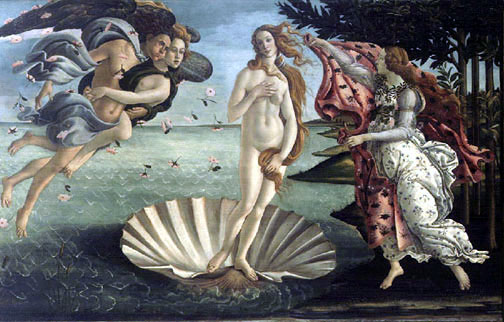“The Birth of Venus” by Sandro Botticelli and stark raving art.
The man stood stark naked in front of the painting. He contemplated it first, then stared at it transfixed. He then slowly began to re-enact the scene: he mimicked the pose, then spread rose petals all around himself. “The Birth of Venus” by Sandro Botticelli portrays the goddess naked on a shell on the seashore; the serene beauty of the nature surrounding her is an ode to her very beauty, the winds gently caressing her hair, the meadow sprinkled with violets, symbols of love. The police arrived shortly thereafter at the Uffizi museum in Florence and arrested the man for indecent exposure.
What was indecent though? His being naked in a public place? Thousands of visitors each year stand before this painting, yet do they really understand or simply appreciate it? Could it be that he – more than anybody else – was truly taken, transfixed, and raptured by the masterpiece and felt that his nudity was his only humble way to pay homage to its grandiosity? In fact, he then knelt down in front of it.
I see nudity where others saw nakedness. I believe that art turns nakedness into nudity, takes the sense of shame out of it – if there was ever supposed to be a shame – and liberates the viewer, who now feels justified to look at it because ‘it is art’. It is therefore supposed to have a meaning and a salvific power towards itself and mankind.
The subject is not merely copied, but transformed by the artist into an aesthetic object. We were born naked. Even when depicting religious scenes, the artists of the past portrayed Jesus and the Saints naked. In ancient Greece – and not only there – gods and goddesses were depicted naked, and so were warriors. True, due to the particularly mild weather, the Greeks would wear little to nothing, but besides this, nudity was almost a celebratory way of expressing themselves and the human body, and male athletes competed at religious festivals entirely nude. It was associated with triumph, glory, health, youth, and a sort of geometric and organic equilibrium. This perfect idealized symmetry was of course better conveyed if the subject was unclothed. Those artworks were not meant to stir the mind and the passions.
The “Birth of Venus” however did. It stirred who knows what sort of sentiment inside that man. And I am sure, not just in him. But he manifested it. I wonder what Botticelli would have appreciated the most: the casual and quick look of the visitor shuffling their feet from one work to the next? The composed demeanor of someone in silent admiration? The aesthetic stare of another, their expression of rapture towards what they are beholding, their feverish desire to be at one with the testimonial of genius and close perfection, pertaining to the divine more than to us? So that they could feel almost compelled to not just witness, but “recreate” the work of art themselves?
“Great art can contain significant sexual content without being obscene” – Kenneth Clark once noted – [and] “great works of art [are such] because their eroticism is part of their whole philosophy”. However, in 2014 a naked man posing no harm is less tolerated or equally tolerated than the many acts of gratuitous violence perpetrated around us every day.
“What spirit is so empty and blind, that it cannot recognize the fact that the foot is nobler than the shoe, and skin more beautiful than the garment with which it is clothed?” (Michelangelo Buonarroti – 1504)
Nicoletta Lucia Paganucci


